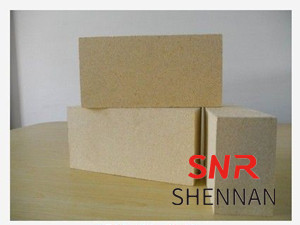
When the clay brick for glass kiln is in contact with the molten glass at high temperature, the surface of the brick body is initially infiltrated by molten glass. After that, due to the action of the capillary, the molten glass is sucked into the pores of the brick, and the alkali metal-rich ions in the molten body will gradually diffuse into the gap of the clinker crystal phase around the pores, and the metasomatism reaction then occurs. The glass liquid first dissolves the free SiO2 in the clay brick, and the mullite is dissolved at a lower rate, so it gathers on the interface between the glass liquid and the clay brick. After that, the small crystallized mullite is dissolved, and the recrystallized and grown (secondary) mullite is produced near the pores or at the interface in contact with the glass liquid. The clinker may also be converted and decomposed into β-Al2O3. Most of these grain sizes are very fine due to the lack of deep interpretation. In addition, the metasomatism reaction also forms a part of the glass phase with a different composition from the original glass liquid. This is because the clinker is partially dissolved, and SiO2 and Al2O3 components are added to the melt, which will diffuse into the rest of the glass liquid.
With the development of the metasomatism reaction, the clinker particles will gradually disintegrate and become residual aggregates, around which mullite and β-Al2O3 may develop and grow, and the aggregation of β-Al2O3 crystals occurs in the interface layer. Nepheline and glass phases may also appear, at this stage Na2O and K2O have penetrated into the middle of the clinker aggregates. It reacts with mullite in clinker as follows:
3 Al2O3·2SiO2+Na2O=NaO·Al2O3·2SiO2+2 Al2O3


When mullite coexists with R2O, it decomposes at lower temperatures. The higher the amount of R2O, the lower the temperature at which mullite decomposes into corundum and nepheline liquid phases. The basic components enter the brick body from the metasomatic interface and diffuse inward gradually, so the basic components in the interface layer are high, and the β-Al2O3 crystals aggregate more.
With the further development of metasomatism, the clinker particles may be transformed into scattered fragments, and even all of them will be transformed into secondary or new ore phases, which mainly include secondary mullite and β-Al2O3 transformed from decomposition. And the nepheline, triclinic nepheline, leucite, orthoclase, albite, etc. generated by the metasomatism reaction. After further erosion, they melt into the glass and become high-alumina streaks or bumps.
This kind of erosion is most intense at the liquid glass surface, where not only the temperature is high, but also at the junction of gas, liquid and solid three-phase, and it will be affected by the lye and nitrate water in the batch. The reaction between salt water and clay bricks produces SiS2, which generates gas when decomposed to foam the metamorphic layer of the bricks, thereby accelerating erosion.
The volatiles of alkali metal oxides can react with clay bricks at 1000-1100 °C, that is, R2O reacts with mullite in clay bricks to form corundum and nepheline glass phases. The latter continues to be subjected to the action of R2O to form a feldspar glass phase. If the main component of R2O is K2O, a strong protective layer of potassium nepheline and β-Al2O3 in the high viscosity area can be formed on the surface of the clay brick. However, if the refractory brick contains less SiO2, the vitreous glaze will peel off after reacting with R2O.
After the clay bricks used in glass kilns are eroded by the dust of the batch materials, a layer of glaze is formed. In addition to the glass phase, this layer of glaze also has complex twin crystals of nepheline, leucite, feldspar and mullite. This glaze layer will run off at higher temperatures. The residue solidifies at the lower temperature of the checkered brick, and it is easy to block the checkered hole, which will greatly reduce the heat storage effect of the checkered brick of the regenerator. Usually clay checker bricks are difficult to use for more than 30 months.
Zhengzhou Shennan Refractory Co.,Ltd are professional in producing high quality clay bricks ,any demands,please don't hesitate contact with me.
 |
+86-15238007351 |
 |
+86-371-86039318 |
 |
annie@snrefractory.com |
 |
www.snrefractory.com |